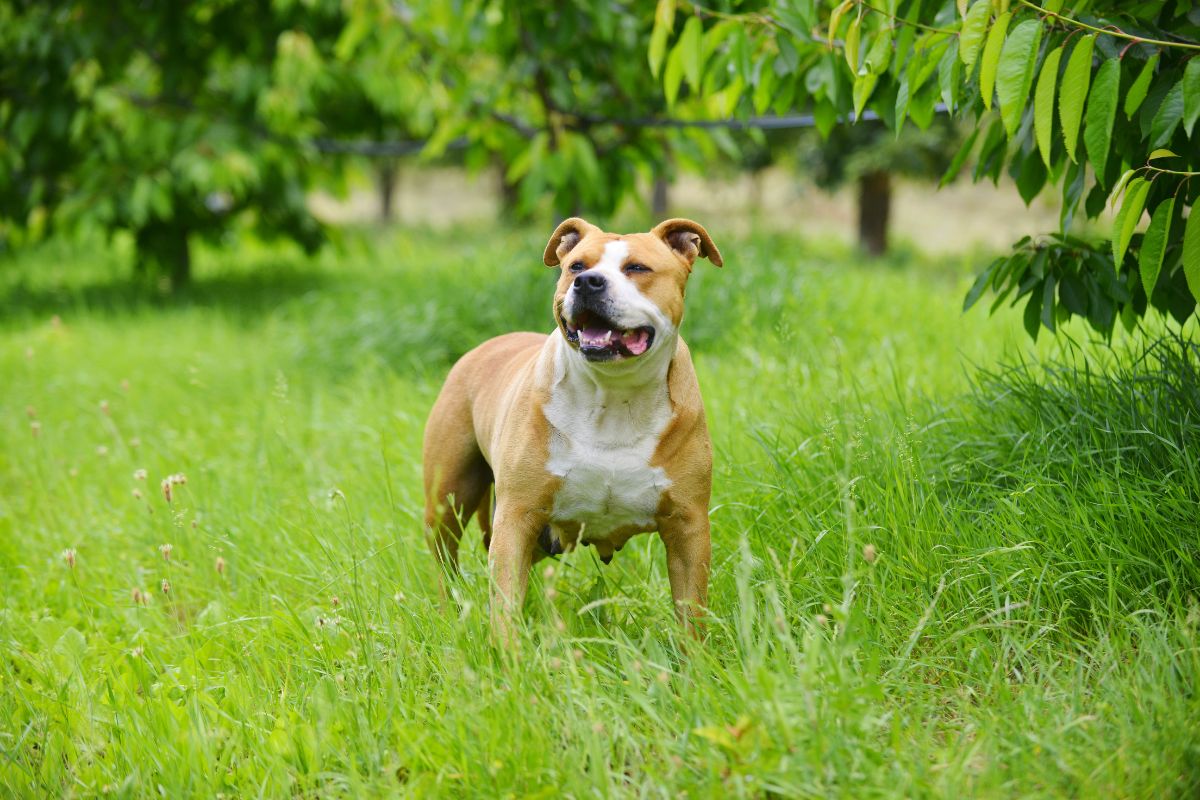When a female dog is “in heat” or “getting into heat,” she is amenable to mating and releases mating hormones.
There are numerous different signs and symptoms which will let you know whether your female dog is going into heat.

However, knowing what to do when your dog is in heat may help you properly prepare for making them as comfortable as possible, keeping males dogs at bay, or perhaps preparing for a pregnancy if that is your intention.
When Is a Female Dog’s First Heat Cycle?
Most dogs will experience their first heat cycle between the ages of six and fifteen months. This varies according to the size and breed of the dog.
Dogs typically go into heat twice a year, or around every 6 months, with little dogs going into heat more frequently than large dogs.
Small dog breeds can experience a heat cycle three times a year, whilst very big dogs might cycle just once a year.
Heat cycles are quite constant, so if your dog has two heat cycles six months apart, anticipate this to continue.
However, your dog may not experience regular periods for up to two years. Keep in mind that the duration of time between heat cycles might grow as a dog ages.
There is no particular age at which a female dog will no longer go into heat; they will continue to go into heat for the rest of their lives unless they are spayed or have a medical problem.
What Are the Stages of the Heat Cycle?
There are four stages in the heat cycle that female dogs will go through, you will be able to have an idea of what stage they are experiencing as they come with different signs and symptoms.
1. Proestrus Stage
When the reproductive tract gets ready for ovulation in a female dog, the first indications of heat develop.
It can continue anywhere from three to seventeen days, however some dogs are only in proestrus for around nine days.
Male dogs may appear more interested in your dog during proestrus, but she is unlikely to be open to mating.
Even if a female dog does mate with a male dog, she will not be able to become pregnant at this point.
The enlargement of the vulva and bloody vaginal discharge are generally the first signs that your dog has entered the proestrus stage.
Other indications include aggression toward male dogs, changes in appetite, and tucking the tail close to the body.
2. Estrus Stage
The estrus phase is the mating period during which your female dog is receptive to males.
Female dogs in heat may also pee in little amounts on various things around the house or outside.
Because female urine carries pheromones and hormones that convey their reproductive status to male canines during estrus.
Although she may leave pee traces in places, her vaginal discharge will decrease and may turn straw in color.
Because your dog is ready to mate, she will approach male dogs with her tail held to the side, but she may be hostile to other females.
3. Diestrus Stage
This third stage lasts around two months and is marked by the female dog’s lack of receptivity to the male.
If she becomes pregnant, her body will either prolong the pregnancy or return to rest when her vulva returns to normal size and the discharge evaporates.
Whether the bitch is pregnant or not, she no longer has the circumstances to mate and is no longer interested in attracting a partner.
4. Anestrus Stage
Finally, there is anestrus, which is a dormant period with no evidence of hormonal or sexual activity.
Signs That Your Dog Is In Heat

You will know what to expect in terms of indicators that your dog is in heat now that you have a better grasp of the different stages of the heat cycle and what they signify for your dog.
Essentially, if your dog exhibits the most of these signs while being physically intact, there is a significant possibility that they are in heat.
1. Swollen Vulva
The vulva is the outer region of a female dog’s reproductive tract. It is made up of two labia (thick tissue folds) that are joined at the top and bottom.
The vestibule is located directly inside the vulva entrance.
The degree of swelling in the vulva varies. Some dogs swell very slightly, while others swell significantly.
2. Bloody Vaginal Discharge
A healthy dog will most likely bleed from the vagina since she is in the proestrus cycle of her heat phase.
They should bleed for around half of the overall cycle, which is generally seven to 10 days.
Typically, the bleeding is modest during the first several days, but by mid-week, it has become thicker.
In general, larger dogs breeds will bleed more compared to smaller breeds, however this varies for every dog. Some dogs bleed infrequently.
It is not normal for them to bleed for the rest of her heat cycle though. If this occurs, you must discover the cause.
It might be a veterinary emergency if she is in discomfort, has purulent discharge, or other signs.
3. Appetite Changes
During the first week, the female dog in heat can get hungrier, therefore you may need to increase the meal portion.
Occasionally some dogs will want to eat less.
Whatever the change is, seeing it might be a key indicator that the heat cycle has begun.
4. Behavior Changes
Changes in your dog’s behavior can vary in severity. They may become clingier with you or more snappy and inclined to remove themselves from being fussed over.
Either way, you should respect their needs.
5. Licking Genital Area Excessively
A female dog or bitch reaches sexual maturity between the ages of six months and one year. When their first heat arrives, they reach sexual maturity.
From this point forward, you may witness your dog humping toy objects, blankets, or other dogs, as well as intensive licking of her private areas. This is a typical and natural habit in dogs.
They do this to masturbate and enjoy themselves. Female dogs lick their privates more frequently when they are in heat.
6. Tucked In Tail
When another dog approaches, the vulva is guarded by tucking the tail between the legs or sitting down.
7. Frequent Urination
A female dog in heat will frequently urinate more frequently than usual.
If you see her urinating’s a little bit on various things in the home or when out on a walk, then this can be described as marking and is also a common symptom of being in heat.
8. Interest In Males
By turning her back toward him and raising her tail up and out of the way, she will be encouraging the male. If there is no male dog around, she may decide to leave the house.
Reasons Why A Female Dog Is Not Going Into Heat

In rare cases, your female dog will have an abnormal heat, such as a split or quiet heat, or will not have a heat cycle at all.
If your female does not come into heat for more than 10 months, her reproductive cycle may be repressed.
Because she has experienced a quiet heat, you may not recognize that your female has cycled on time.
This occurs when your dog becomes pregnant but does not display any of the typical symptoms of a normal heat cycle.
During a quiet heat, your female might still become pregnant.
It is critical to keep an eye on any intact male canines; they will be able to sense a quiet heat.
Hypothyroidism
Aside from quiet heat, the reason your dog may not appear to be in heat is that your dog may have a thyroid condition, which can induce inconsistent heat cycles and, in severe circumstances, result in a female dog to not cycle at all.
Hypothyroidism is assumed to be inherited, therefore dogs that have this condition are best not to be bred from.
Malnutrition
Female dogs that are underweight due to a poor diet or a recent sickness can frequently lack a heat cycle.
Providing a low-quality dog food with low protein and fat content may result in your female not having a heat cycle.
If you intend to breed your female, provide her high-quality food to ensure that her body produces enough estrogen for a normal heat cycle.
Ovarian Hypoplasia
In other cases, the ovaries do not fully mature and are unable to produce enough estrogen for the female dog to enter heat or have a regular heat cycle.
The vulva and mammary glands will remain small and undeveloped.
Ovary Tumor
Tumors can form for a variety of causes, some of which are malignant and others of which are benign.
When a tumor forms on your female ovaries, it might disrupt heat cycles.
Your veterinarian will need to do diagnostic testing to confirm the presence of a tumor and whether it is malignant.
What To Do When Your Dog Is In Heat
It might be difficult to care for your dog during their heat cycle. Hormone fluctuations can have a significant physical and behavioral influence on her.
Fortunately, there are strategies to help this time go as smoothly as possible.
Frequent Walks
While in heat, she may need to urinate more frequently, and modest movement might help her release pent-up tense or aggressive energy.
Think about taking her for walks in the early morning or late evening, when there is less dogs in your area.
If your dog appears fatigued, never force her to go for a walk; instead, let her rest.
Provide Nutritious Food
During the heat cycle, female dogs and their appetites often shift. While the majority of dogs’ appetites may drop, others may notice an increase.
Whether your dog has a tiny appetite or is hungrier than normal, providing nutritional food is critical.
Look for foods that contain the perfect amount of fiber, vitamins, and other nutrients to keep your dog strong, healthy, and happy during heat.
Brush And Massage Her
Female dog aggression during heat is a typical complaint.
Even if they have never been aggressive before, drastic hormone fluctuations might have a negative impact on her attitude and predispose her to act aggressively.
These hormonal changes produce irritation, agitation, and even discomfort during ovulation, adding to the uneasiness and potential violence.
If your dog is apprehensive and is okay with you touching her, spending the time to stroke her, rub her, and brush her coat will be comforting and relaxing for her.
It’s important to note that not all female dogs show aggression during heat.
Offer Chew Toys
To let out some of that pent up aggression or frustration, you can provide your dog with chew toys that will not only release this energy but will also keep them busy and distracted.
Give Her Space If She Wants It
Not all dogs will feel clingier when in heat, and instead will want to remove themselves and tuck themselves away into the corner.
You should not be concerned with this unless they are not eating or drinking and are showing signs of pain.
When they want space, you should respect it and let them relax by themselves.
It is nothing personal, they are just going through a lot of hormonal and physical feelings that can become quite stressful when paired with constant fussing.
Cleaning Up
Blood is a very common symptom of a dog in heat, and the amount varies from dog to dog. While she will do her best to keep herself clean by licking, some extra cleaning may be required.
This might be as basic as giving her a wash or spot cleaning every now and again.
Dog diapers or trousers may be useful if you want to minimize stains on your carpet or furniture while still allowing your dog access to all areas of your home.
If your dog likes to be left alone, covering furnishings and confining your dog to a certain part of the house may be essential.
Know When To Contact The Vet
A female dog’s health may suffer following a heat cycle if the uterine lining stays thicker and generates more fluid, producing an excellent habitat for bacterial development.
This can result in a potentially fatal pyometra, or uterine infection.
A pyometra in a pet might cause excessive drinking or urination, thick vaginal discharge, a reduced appetite, stomach discomfort, vomiting, or lethargy.
Preventing Pregnancy

If you do not want to breed your dog, you must focus on keeping her away from persistent males by regulating her surroundings.
A smart place to start is to keep the windows closed to reduce the chances of male dogs coming up at the door to garner her attention.
Of course, you must keep your girl out of reach. If you take her for a stroll, keep her leashed.
Open doors with caution, since she may bolt even if she has never shown any interest in doing so previously.
Males have been found to hop over fences, and some are even capable of reproducing through a chain-link fence.
You can utilize things to keep up with male dogs. One of these treatments is a spray that is claimed to make a female dog scent as though she has already been bred, causing males to lose interest.
Terminating Unwanted Pregnancy
Sometimes, no matter what precautions you have taken whilst your dog is in heat, something can go wrong and your dog mates.
In this case, you should try not to panic as there are still ways that you can prevent puppies.
A’mis-mating injection’ is one such method.
If you believe your dog mated during the past 22 days, an antiprogestagenic medication called Alizin may be administered.
This drug will stop the growth of a cluster of cells within your dog and is very effective within 22 days of mating.
It can also be given later in the pregnancy, although it will be less effective.
Injections are a useful preventive strategy, especially when administered early. However, this is not a long-term treatment and will not safeguard you from future pregnancies.
It is suggested that you spay your dog if you want a long-term solution.
If spaying and miscarriage injections are not a possibility, a veterinarian abortion is a feasible and successful method of terminating an undesirable pregnancy.
However, deciding to have an abortion is a major medical choice for your dog. Abortion is more likely to cause difficulties than mis-mate injections or spaying.
Most veterinarians will not do them unless the dog is too far along for other choices and pregnancy is not an option for health or personal reasons.
Depending on the dog’s stage of pregnancy, veterinarians may perform a surgical abortion or use abortifacient drugs to end the pregnancy.
Abortions are hard on a dog’s body, and they frequently need to stay in the animal hospital for up to a week to recuperate.
Abortions are very costly, especially if the dog is late-term, and they provide no protection against future unwanted pregnancies, unlike spaying.
Preventing Your Dog From Going In Heat
If you do not want to breed your dog during a heat cycle, not only may undesirable symptoms such as behavioral changes and vaginal discharge be difficult to control, but your dog may get pregnant as a result of an unexpected mating.
Megestrol acetate can postpone or prevent heat cycles if your dog is unable to be spayed due to a medical problem or if you want to breed her later.
Mibolerone and proligestone are two more drugs that prevent and permanently inhibit heat cycles, however they are not accessible in the United States.
In one study, megestrol acetate was reported to be 92% effective in delaying heat cycles in dogs in the early proestrus phase and 98% effective in dogs in the anestrus phase.
Megestrol acetate should not be given to dogs that have not yet had their first heat cycle.
Female dogs should not mate within 30 days of finishing their megestrol acetate treatment. This drug should not be used for more than two heat cycles.
Dogs receiving this medicine must be closely monitored due to the possibility of major adverse effects.
Your dog’s weight, liver function, blood sugar levels, and reproductive health will all be evaluated by your veterinarian. Tests can also establish how effective the drug is.
Spaying Your Dog
Spaying dogs is the most effective technique to keep them from becoming pregnant.
This not only avoids unplanned births, but also various serious reproductive illnesses such as pyometra and cancer.
Spaying a dog is the removal of a female dog’s reproductive organs, whereas neutering is the treatment for males.
When a female dog is spayed, her ovaries and, in most cases, her uterus are removed. Spaying a female dog prevents her from reproducing and ends her heat cycle.
Benefits Of Spaying

There are many benefits that come with spaying your dog and involves more than just the prevention of an unwanted pregnancy.
Reduces The Risk Of Cancer
Spaying a dog before her first estrous cycle significantly decreases her risk of getting breast cancer and fully eliminates the risk of uterine, ovarian, and uterine infection, all of which are frequent in unaltered females.
Less Likely To Roam
Spaying your female pet reduces the number of stray males in your yard and reduces her urge to mate and roam in hopes of finding a male.
Avoids The Mess
In houses with such animals, continual precautions must be made to prevent carpet stains since female dogs discharge bloody fluid twice a year for around ten days as a part of their estrous cycle. By spaying your dog, you can solve this issue.
Prevents Overpopulation
Millions of unwanted dogs are put to sleep at shelters around the country each year.
The more pets who are spayed or neutered, the fewer dogs that end up being euthanized.
When Should You Spay Your Dog?
The usual age for spaying or neutering a dog is between four and six months, while dogs as young as two months old can be successfully spayed or neutered at a spay clinic or shelter.
However, each owner should consult with their own veterinarians about their unique situations.
The timing of spaying and neutering can be influenced by a number of circumstances.
Female dogs should be spayed before their first heat cycle, according to most vets. This varies, but it usually happens between the ages of five and ten months.
Possible Pregnancy Complications

If your dog does fall pregnant, they are not yet out of the woods when it comes to things that could go wrong.
Pre-eclampsia
Growing infants use the calcium supply from the mother to develop teeth and bones throughout pregnancy and breastfeeding.
Sometimes the mother’s body is unable to keep up with the increased calcium demands.
A dangerous disease known as pre-eclampsia can emerge if the mother’s blood calcium level becomes too low.
A dog or cat suffering from pre-eclampsia may become agitated, frightened, and confused. Her legs stiffen and she walks with a stilted pace.
As her body temperature and respiration rate rise, she may pant. Tetany (excessive stiffness) develops in severe instances, which can be fatal.
Mastitis
As milk production begins, the mammary glands increase toward the end of pregnancy.
Nursing is normally painless, but some females have mastitis, a painful illness caused by inflammation or infection of the mammary glands.
Mastitis is most common in the first two weeks following birth. Mastitis can affect any or all of the teats and milk glands seen in dogs and cats.
Retained Placenta
The placenta is a sac that protects the embryo in gestation and is generally removed after the infant is born as “afterbirth.”
The placenta is generally discharged within 15 minutes of each puppies delivery, but if the placenta lingers in the uterus, complications emerge.
Because you can’t see inside the uterus, it’s difficult to detect when a placenta fails to discharge.
It is difficult to compare the number of pups born to the number of placentas evacuated since the mother frequently swallows the placentas.
As a result, it is critical to constantly monitor mothers after the pups are delivered for indications of retained placenta, such as vomiting, decreased appetite, fever, lethargy, or stained vaginal discharge.
Gestational Diabetes
The metabolism of glucose is a fundamental function of life.
The body of a pet breaks down carbs from meals to generate glucose. Insulin is required for body cells to absorb glucose from the blood.
Gestational diabetes, like other types of diabetes, develops when the body either does not make enough insulin or does not use the insulin that it does produce.
Gestational diabetes develops throughout pregnancy, as the term indicates (gestation).
The management of gestational diabetes is crucial to the health of both the mother and the pups.
Your veterinarian will run blood tests to evaluate your pet’s glucose levels and, if necessary, will prescribe insulin injections.
Diabetes treatment necessitates meticulous attention to food, proper insulin administration techniques, and constant monitoring of blood glucose levels.
Summary
The signs that your dog is in heat are usually consistent and will differ depending on the four stages of the heat cycles that they are in.
However, as you can see, having an intact female dog can be a lot of work when their heat cycle comes around.
Not only do you have to keep an eye out for bloody discharge and urination spots on your carpet and furniture, but you also must be aware of other male dogs coming into contact with your female dog.
Not only this, but some female dogs can become more aggressive or nervous during this time which can put a bit of strain on your relationship unless you do the research and know when to give them space or when to give them extra attention.
It is not recommended to take your dog for walks off leash when they are in heat as there is a risk of male dogs coming too close. This can become a bit frustrating for your female dog if they are stuck inside with no way to expend their energy.
To remedy this, there are plenty of puzzle toys, chews, and games that you can use instead.
Knowing how many complications that can come with becoming pregnant for a dog, it should help convince you to spay your dog as it will make both of your lives much easier but will also prevent lots of other health issues such as breast cancer, uterine cancer, and of course unwanted pregnancies.
- 8 Signs That Your Dog Is In Heat - November 8, 2022
- Why Is My Dog Whining Whilst Carrying A Toy In Their Mouth? - August 17, 2022
- Reasons Why Your Dog’s Poop Is White And What To Do About It - August 17, 2022








